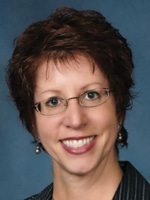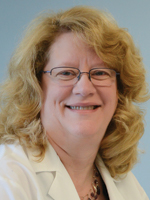December 2021—The staffing crisis lives on, despite labs having plans of all kinds in place to alleviate the shortage. “It’s the only thing we’re talking about,” Ochsner Health’s Greg Sossaman, MD, said on Nov. 2 when members of the Compass Group met by Zoom. SARS-CoV-2 testing and test supplies and vaccination are “taking a back seat” to staffing, he said.
CAP TODAY publisher Bob McGonnagle led the roundtable last month, when COVID-19 positivity rates were up in some areas and down in others. Here is what Dr. Sossaman and other lab leaders had to say.
The Compass Group is an organization of not-for-profit IDN system lab leaders who collaborate to identify and share best practices and strategies.
I want to briefly discuss president Biden’s vaccination requirements to get COVID under control and the implications for labs of the testing requirement for the unvaccinated. They could put a big burden on laboratory systems. Is that how you see it, John Waugh?
John Waugh, MS, MT(ASCP), system VP, pathology and laboratory medicine, Henry Ford Health System, Detroit: There are a number of components to the president’s announcement: He hands off to the Department of Labor, the Department of Labor hands off to OSHA, and then OSHA has to come up with the rules, and it said it will take weeks, not days, to get that done. All of us have waded through OSHA rules before and know they are usually comprehensive. That’s what we can expect when it comes out from OSHA. Then there will be the states, and CMS will have its own rules for Medicare and Medicaid.
Some of the questions we need to consider are when do these rules start and when do they end? What kind of testing will be accepted? Is it PCR or antigen testing, which might broaden the toolbox? A lot of us refer to the tests as PCR, but some are other amplification techniques like loop-mediated isothermal amplification or transcription-mediated amplification. What type of tests are accepted? How do the results get reported? Who pays for this? What if the employer is closed for a week or what if an employee is on vacation? Will employers be required to pay employees for time off to get tested? There are a lot of layers of complexity that could be in these regulations and a lot of questions that will come out in a review session.

Mirkes
Linda Mirkes, what are your thoughts on such testing?
Linda Mirkes, MBA, MT(ASCP), assistant VP, core laboratory and integration, Atrium Health, Charlotte, NC: We started to explore some antigen testing whereby people take testing kits home to self-administer the test and then report back through apps. We’ve been investigating this type of usage and keeping the COVID testing in the laboratory for patients and for those who need to have a specific PCR test.
We’re seeing declines in COVID cases as reported by the major media. Does anyone have a different experience from what’s being reported?
Stan Schofield, president, NorDx, and senior VP, MaineHealth: We are still at the peak. We hit the maximum per patient hospitalizations last Friday. It’s a little lower this week.
We ran 3,000 tests today. We’re running 18 percent positive for symptomatic patients and five percent for asymptomatic patients. So what the country went through and the South went through, we’re six to eight weeks behind that because we are a highly vaccinated state.

Dr. Lyzak
Judy Lyzak, how is the spread of COVID affecting Alverno now?
Judy Lyzak, MD, MBA, VP of medical affairs, Alverno Laboratories, Indiana and Illinois: We are declining more in our Illinois hospitals than in our Indiana hospitals. We have hospital hotspots where we’re still at the same level Stan referred to. We are in the high teens, low 20 percents on our symptomatic patients and from one to five percent on our asymptomatic, preprocedure screens. It’s better but still concerning. And we’re on the precipice of trying to integrate employee testing into that mix. So—challenging days.
Dan Ingemansen, what’s your experience in Sioux Falls?
Dan Ingemansen, senior director, Sanford Health, Sioux Falls, SD: Here in the Dakotas we hit our peak late September. Since, our volume decreased 15 percent and remained flat the past five weeks. Positivity rates continue to increase since our peak, currently around 20 percent across Sanford Health.

Wong
Dhobie Wong from Sutter, can you tell us what’s going on in Sacramento and Northern California?
Dhobie Wong, MBA, MLS(ASCP), CLS, VP of laboratory services, Sutter Health, Sacramento, Calif.: We are still seeing a demand for testing, especially with the mandate for unvaccinated employees. We are fortunate we do not see much attrition due to that mandate. Overall our vaccination rates within the health system are at 92 percent. With the cutoff date approaching, we’re seeing only a handful of individuals who have exemptions for the vaccine and we are working through the options for testing them. We are leaning toward an over-the-counter test.
Someone who has been reading the Compass Group roundtables said to me when we were at the AACC meeting, “If the Compass Group labs are having labor shortages, what can we possibly do to keep the lights on and keep the machines running?” Dwayne Breining, do you have a reaction as a Compass Group member to this comment?
Dwayne Breining, MD, executive director, Northwell Health Laboratories, New York: We’re still figuring out our multipronged strategy for dealing with this. We have medium-term and long-term solutions lined up, including opening our own medical technology program and partnering with the middle schools and high schools in the region. One of my colleagues said we have to demonstrate to people that lab testing can be sexy. It’s always been sexy, but we let it fall off the radar.
The amount of interest we get from the school kids who come through and our educations group is fantastic. They have students doing point-of-care testing, dipstick testing, glucose testing, and it’s been received with a lot of enthusiasm by the teachers and kids. It does not take that much to get people interested once they see the high-tech things we do.
We have a rapidly aging labor force throughout the country, and in the New York metropolitan area it’s even worse, so we need to have short-term measures to do more with less to hold on to the people we have. We’re looking at switching over to a three- or four-day workweek and setting up the work environment to be as pleasant as possible.
You spend half of your waking hours at work—that’s the reality of life in the U.S.—so we’re trying to make it pleasant and enjoyable at all of our workplaces. For example, we’re running a billiards tournament at the core lab right now.
Sterling Bennett, do you want to comment on how COVID is affecting Intermountain now?
Sterling Bennett, MD, MS, senior medical director, pathology and laboratory medicine, Intermountain Healthcare, Salt Lake City: We’ve been on a seven-week plateau, and the big problem with that is our hospitals continue to be full. We are postponing elective surgeries if they are likely to require a hospitalization afterward. We’re still scrambling to meet patient needs in a COVID situation that is not following the national trend downward.
After listening to some of you, it seems we’re still in a serious situation, and the national media is not getting the correct story. What do you think, Greg Sossaman?
Greg Sossaman, MD, system chairman and service line leader, pathology and laboratory medicine, Ochsner Health, New Orleans: We’ve had a tremendously bad surge in the summer months, but that has largely resolved. Our most pressing issue now is keeping the lights on and the machines running.
The staffing scenario is bleak. We have short-, intermediate-, and long-term plans for staffing but we’ve hit such a crisis point with the pandemic with people retiring and choosing to go into other fields. It’s the only thing we’re talking about. Secondary are the supply issues, COVID issues, vaccine mandate and testing—things like that. Those are taking a back seat to our primary job of ensuring the lab has basic functioning.
One of the concerns I’ve heard expressed from many in vitro diagnostics companies is they realize their customers are hurting on the labor side and they’re worried about whether you’ll have budgets for acquisitions and new instrument reagent rentals, and whether you will be able to keep up with the expansions you’d like to do in terms of your service offering.

Dr. Wilkerson
Myra Wilkerson, would you talk about how difficult the budgeting cycle must be at Geisinger this year? And how is the labor situation there?
Myra Wilkerson, MD, chair of laboratory medicine, Geisinger, Danville, Pa.: The budget cycle is interesting. We went from a traditional budget to a rolling forecast budget this year, so we’re still figuring out exactly what that means. And our budgets are tight.
The labor situation is terrible. A lot of med techs are my age and they’re tired of working and ready to quit. Our pathologist assistants are quitting also, and they’re really hard to find. Because a lot of them were taking temp jobs, they can make more money elsewhere, work during the parts of the year they want to, and live in interesting places. If you’re young and unmarried, why wouldn’t you do that? I can’t blame them, but it makes life uncomfortable.
The gross room has changed a lot since I did my training. I can still gross things, but to try to use voice dictation and all the automated systems now would be difficult.
Sarah Province, tell us about your budget cycle. Do you expect to have discretionary dollars after you deal with labor and such things as IT security issues?
Sarah Province, director of laboratory operations, AdventHealth, Orlando, Fla.: We just finished our budget preparation for next year, and it was interesting working through some pricing increases with our blood supplier. They have increased rates for our platelets, for example. We had increased expenses in our molecular department, but also new testing that we will be able to bill for. It was an interesting exercise in looking at the revenue balance. Otherwise, we closed well and we were able to allocate labor dollars where we needed them. It wasn’t too painful.
As some of the COVID testing volumes go down, so too does some of that income. Were you able to figure that into the mix?
Sarah Province (AdventHealth): Yes, we did take that into account. With less COVID testing, we have fewer related expenses. But our outreach market is growing, so it’s backfilled with new clients and additional patient test volume.

Dr. Quigley
Michael Quigley, tell us what you’re dealing with in San Diego.
Michael Quigley, MD, PhD, vice president, diagnostic services, and medical director, Scripps Health core laboratory, San Diego: We are considering a request for point-of-care testing for troponin in the ED. The laboratory has concerns about the performance of POC troponin assays compared with current laboratory-based contemporary assays as well as the anticipated ultrasensitive assays that will likely become more widely available next year. The added cost of POC testing also has to be figured in.
We are working on the recently published recommendations to remove race from the eGFR equation.
The adoption of new equations is gaining momentum. Do you see that in Maine, Stan Schofield?
Stan Schofield (NorDx): We have such a small minority population, but our technical people are working on it and the quality people started making adjustments.
Dr. Quigley (Scripps): We are working on making the switch to the equation without race as soon as we can.
Dr. Breining (Northwell): We’re in the process now at Northwell.
What is happening in Little Rock with COVID cases, staffing, and laboratory budgets?
Angela Boast, CG(ASCP), MLS(ASCP), quality assurance laboratory manager, University of Arkansas for Medical Sciences, Little Rock: As far as COVID cases, we are on a decline. We only had six inpatients this week.
Amy Trickett, MBA, administrative director, laboratory and pathology services, University of Arkansas for Medical Sciences: We are having the same staffing issues as others. We’re still running a full-service lab, and a lot of our labs are 24/7. Our staff volunteer to work double shifts. We’re having trouble especially in histology, trying to find specialized employees for that area. We’ve been down about five histotechnologists for the past couple of months, so our managers and supervisors in those areas are working six to seven days a week. So yes, we’re struggling.
We will start on our budget at the end of December. We are under budget so far for fiscal year ’22 and staffing is about $1 million under budget. Our supply is about $1 million as well. That shows you the staffing issues we have with open positions and with COVID testing declining, because we budgeted for large amounts of COVID testing. Normally at this time we’re way over budget, which is normal for labs.
Peter Dysert, tell us about COVID rates and testing in Texas.
Peter Dysert, MD, chief, Department of Pathology, Baylor Scott & White Health, Dallas: At Baylor in north Texas, we see a continued decline in the number of tests and percent positivity. Our analysis of our variants shows a delta dominance, though we have a rare additional variant show up occasionally. We continue to see a low prevalence of influenza and adenoviruses.
Our laboratory staffing is challenging, and our nursing colleagues are equally challenged. Pre-COVID at Baylor University Medical Center, our vacancy rate in nursing was five percent. At a general nursing level, it’s now 20 percent. In our ICU areas, it’s more than 30 percent.

Dr. Rao
Arundhati Rao, tell us about those same issues at Baylor Scott & White in central-north Texas.
Arundhati (Ari) Rao, MD, PhD, senior VP, chief pathology and lab medicine officer, Baylor Scott & White Health, Temple: There’s been a pretty sharp decline in COVID numbers and tests. We are seeing the same challenges with staffing—up to a 30 percent vacancy rate.
Phlebotomy is being asked to increasingly cover, given the nursing shortage, but is also seeing a 15 to 20 percent vacancy rate. We’re also seeing shortages in PAs and grossing assistants on the AP side. Challenges everywhere as far as staffing goes.
Peter Dysert, do you suspect that another variant is imminent and will come into the population?
Dr. Dysert (Baylor Scott & White): Looking at the variant analysis we’re doing now in the Dallas area, and Dr. Rao is doing the same thing in central Texas, I don’t think we’ve seen a variant yet at a level that raises concern. I think everybody is speculating that under the pressure of vaccination and the virus itself, it’s a possibility in the future.
Dr. Rao (Baylor Scott & White): We are sequencing across the system looking for unexpected variants including AY.4. While we have not seen variants yet, monitoring is important.
Jim Crawford, have you seen any of the other variants?
James Crawford, MD, PhD, professor and chair, Department of Pathology and Laboratory Medicine, and senior VP, laboratory services, Northwell Health, New York: The New York area remains dominated by what might be called the traditional delta. The other variants have not gained traction more than single percents. So in terms of public health planning, there hasn’t been change.
One of the discussion points in the New York consortium is about the vast reserve of an unvaccinated world population and the travel patterns of the people in and out of the United States, especially in major metropolitan areas like New York, and how that has set us up for variant development elsewhere in the world and entry into the United States. We can talk about the pressure of vaccination in the United States, but the greater concern, at least among New York colleagues, is the incubators elsewhere in the world and the need for world vaccination, not just vaccination in the United States. The premise is, if there is a variant it’s going to land in our area, so the need for monitoring remains strong. Right now, we remain a delta environment.

Beylo
Frank Beylo, can you tell us what’s going on in Virginia?
Frank Beylo, BS, MT(ASCP), director, operations and technology, Inova Health Systems, Falls Church, Va.: To help with staffing concerns like everyone else, we’ve started introducing shift bonuses for staff to take on extra shifts. We are not sure how well this will work until staff have a chance to look at the criteria needed to qualify and how that fits in with their current schedule. We are also looking at some 10-hour days or different kinds of shifts. Our histology department is extremely busy and they are also struggling to maintain much needed staffing levels with a nationwide shortage of histotechnologists. We have brought in some agency staff to assist in both our histology and core labs. We’re also in the midst of an Abbott automation line implementation.
Our budget cycle is almost done, and once that was submitted, administration came back with requests to cut our expenses as a clinical platform for 2022, in the $6 to $10 million range, which includes the laboratory services, respiratory, nutrition, and imaging departments.
Our COVID numbers have been steady. Our percentage rates are a little less than four percent for our PCRs and less than one percent for our ID Now. Our Liat testing is increasing, and we’re looking at perhaps putting ID Now testing in our urgent cares. They’re only using the Sofia combos now, but they’re looking into using the ID Now for additional testing.
The supply chain has been a big challenge with ID Now, and Liats are on allocation as well as Cepheid reagents. It’s almost a full-time job trying to manage what’s coming and what we have and trying to meet the providers’ various testing requests.
John Waugh, what’s the COVID rate in the Detroit area, and what is your gut feeling about the flu season?
John Waugh (Henry Ford): We’re running a six- or seven-week positive rate of about 12 percent.
We do not have flu in the Midwest yet and we’re not testing for it at this time. It is a background test on some of our Liat analyzers and we keep those results internally. It gives us the ability to surveil influenza, and we’re not seeing it even in the multiplexed testing that is going out.
The jury is still out on flu season. We’re seeing a positive influence from masking and distancing and people have gotten to be expert handwashers over the past two years. But influenza morphs just like COVID, and if it gets pressured we’ll potentially see variants.
Finally, where are you with PAMA reporting?
John Waugh (Henry Ford): We have the data accumulated from the prior year. I asked our revenue cycle people to make sure to archive so we have access to it. I don’t want it to get too far away from us. We expect we will have to do a submission, and it’s going to be a big one because it’ll be a six-month submission, a step up from the three-month submission last time. So no rest for the wicked.